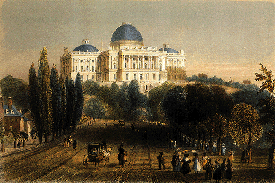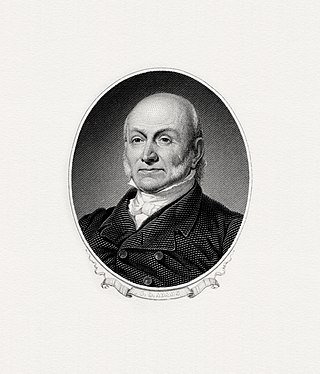
John Quincy Adams was the sixth president of the United States, serving from 1825 to 1829. He previously served as the eighth United States secretary of state from 1817 to 1825. During his long diplomatic and political career, Adams served as an ambassador and also as a member of the United States Congress representing Massachusetts in both chambers. He was the eldest son of John Adams, who served as the second president of the United States from 1797 to 1801, and First Lady Abigail Adams. Initially a Federalist like his father, he won election to the presidency as a member of the Democratic-Republican Party, and later, in the mid-1830s, became affiliated with the Whig Party.

Presidential elections were held in the United States from October 26 to December 2, 1824. Andrew Jackson, John Quincy Adams, Henry Clay and William Crawford were the primary contenders for the presidency. The result of the election was inconclusive, as no candidate won a majority of the electoral vote. In the election for vice president, John C. Calhoun was elected with a comfortable majority of the vote. Because none of the candidates for president garnered an electoral vote majority, the U.S. House of Representatives, under the provisions of the Twelfth Amendment, held a contingent election. On February 9, 1825, the House voted to elect John Quincy Adams as president, ultimately giving the election to him.

In United States history, the gag rule was a resolution in the United States House of Representatives that forbade legislators from raising, considering, or discussing slavery. First passed in 1836 and renewed in some form in every legislative session until its repeal in 1844, the gag rule played a key role in escalating sectional tensions over slavery and galvanizing support for its abolition.

The 20th United States Congress was a meeting of the legislative branch of the United States federal government, consisting of the United States Senate and the United States House of Representatives. It met in Washington, D.C. from March 4, 1827, to March 4, 1829, during the third and fourth years of John Quincy Adams's presidency. The apportionment of seats in the House of Representatives was based on the 1820 United States census. Both chambers had a Jacksonian majority.
The National Republican Party, also known as the Anti-Jacksonian Party or simply Republicans, was a political party in the United States which evolved from a conservative-leaning faction of the Democratic-Republican Party that supported John Quincy Adams in the 1824 presidential election.

Charles Francis Adams Sr. was an American historical editor, writer, politician, and diplomat. As United States Minister to the United Kingdom during the American Civil War, Adams was crucial to Union efforts to prevent British recognition of the Confederate States of America and maintain European neutrality to the utmost extent. Adams also featured in national and state politics before and after the Civil War.

A joint session of the United States Congress is a gathering of members of the two chambers of the bicameral legislature of the federal government of the United States: the Senate and the House of Representatives. Joint sessions can be held on any special occasion, but are required to be held when the president delivers a State of the Union address, when they gather to count and certify the votes of the Electoral College as the presidential election, or when they convene on the occasion of a presidential inauguration. A joint meeting is a ceremonial or formal occasion and does not perform any legislative function, and no resolution is proposed nor vote taken.

The 1828–29 United States House of Representatives elections were held on various dates in various states between July 9, 1828, and October 5, 1829. Each state set its own date for its elections to the House of Representatives before the first session of the 21st United States Congress convened on December 7, 1829. Elections were held for all 213 seats, representing 24 states.

The 1826–27 United States House of Representatives elections were held on various dates in various states between July 3, 1826, and August 30, 1827. Each state set its own date for its elections to the House of Representatives before the first session of the 20th United States Congress convened on December 3, 1827. They occurred during John Quincy Adams's presidency. Elections were held for all 213 seats, representing 24 states.
Events from the year 1828 in the United States.

The inauguration of John Quincy Adams as the sixth president of the United States took place on Friday, March 4, 1825, in the House Chamber of the U.S. Capitol in Washington, D.C. The inauguration marked the commencement of the only four-year term of John Quincy Adams as president and the first term of John C. Calhoun as vice president. Adams was the first president to have been the son of a former president–John Adams; and Calhoun, at age 42 on Inauguration Day, was the second-youngest vice president.
Like most contemporaries, John Quincy Adams's views on slavery evolved over time. He never joined the movement called "abolitionist" by historians—the one led by William Lloyd Garrison—because it demanded the immediate abolition of slavery and insisted it was a sin to enslave people. Further, abolitionism meant disunion and Adams was a staunch champion of American nationalism and union.

The 1828 United States elections elected the members of the 21st United States Congress. It marked the beginning of the Second Party System, and the definitive split of the Democratic-Republican Party into the Democratic Party and the National Republican Party. While the Democrats cultivated strong local organizations, the National Republicans relied on a clear national platform of high tariffs and internal improvements. Political scientists such as V.O. Key Jr. consider this election to be a realigning election, while political scientists such as James Reichley instead see the election as a continuation of the Democratic-Republican tradition. Additionally, this election saw the Anti-Masonic Party win a small number of seats in the House, becoming the first third party to gain representation in Congress.

The 1827 State of the Union Address was written by John Quincy Adams, the sixth president of the United States. It was given on Tuesday, December 4, 1827, to the United States House of Representatives and United States Senate. Adams said, "A revolution of the seasons has nearly been completed since the representatives of the people and States of this Union were last assembled at this place to deliberate and to act upon the common important interests of their constituents." It was given to the 20th United States Congress.
The 1800 State of the Union Address was given by John Adams, the second president of the United States, on Tuesday, November 11, 1800, to a joint session of the 6th United States Congress. It was the first State of the Union Address delivered at the new United States Capitol in Washington, D.C.

The 1913 State of the Union Address was given by Woodrow Wilson, the 28th president of the United States, on Tuesday, December 2, 1913. It was given directly to the 63rd United States Congress by the president as a speech. Wilson was the first to deliver it as a speech, rather than a written message, since John Adams in 1800. With a few exceptions all addresses since then have been given directly following Wilson's lead.
The 1799 State of the Union Address was given to the United States Congress, on Tuesday, December 3, 1799, by the second president of the United States, John Adams. He said, "the return of health, industry, and trade to those cities which have lately been afflicted with disease, and the various and inestimable advantages, civil and religious, which, secured under our happy frame of government, are continued to us unimpaired, demand of the whole American people sincere thanks to a benevolent Deity for the merciful dispensations of His providence." It was the last address to be given at Congress Hall, Philadelphia.
The 1825 State of the Union Address was given by John Quincy Adams, the sixth president of the United States. It was given to the 19th United States Congress, on Tuesday, December 6, 1825. He said, "In taking a general survey of the concerns of our beloved country, with reference to subjects interesting to the common welfare, the first sentiment which impresses itself upon the mind is of gratitude to the Omnipotent Disposer of All Good for the continuance of the signal blessings of His providence, and especially for that health which to an unusual extent has prevailed within our borders, and for that abundance which in the vicissitudes of the seasons has been scattered with profusion over our land." He ended with, "And may He who searches the hearts of the children of men prosper your exertions to secure the blessings of peace and promote the highest welfare of your country."

American politician John Quincy Adams served as President of the United States (1825–1829) and United States Secretary of State (1817–1825). Prior to being president, he had served as United States Senator from Massachusetts (1803–1808) and had diplomatic experience as United States Minister to United Kingdom (1815–1817), Russia (1809–1814), Prussia (1797–1801) and the Netherlands (1794–1797). After losing the 1828 presidential election, he served as a member of the U.S. House of Representatives from Massachusetts for 17 years. He is the only American president to be elected to the House of Representatives after leaving office.
The 1826 State of the Union Address was delivered by the 6th president of the United States, John Quincy Adams, on December 5, 1826, to the 19th United States Congress. Adams began by noting the prosperity and peace that the nation enjoyed, emphasizing the increase in population, wealth, and national resources. He expressed gratitude for the nation’s overall well-being, stating that “we continue to be highly favored in all the elements which contribute to individual comfort and national prosperity.”











